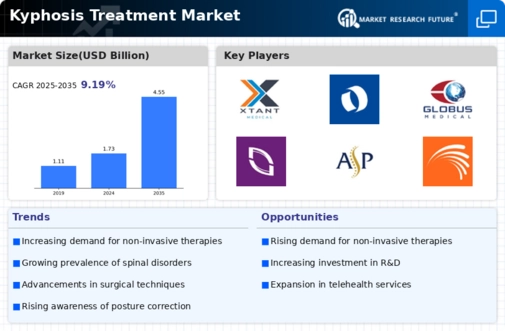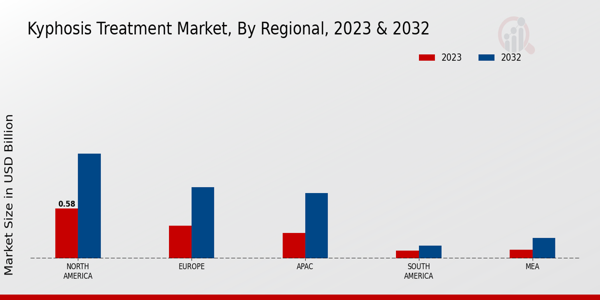Market Growth Projections
The Global Kyphosis Treatment Market Industry is poised for substantial growth, with projections indicating a market size of 1.73 USD Billion in 2024 and an anticipated increase to 4.55 USD Billion by 2035. This growth trajectory suggests a compound annual growth rate of 9.2% from 2025 to 2035. Such projections reflect the convergence of various factors, including rising prevalence of kyphosis, advancements in treatment technologies, and increased awareness among patients and healthcare providers. The market's expansion is indicative of a broader recognition of spinal health's importance, as well as the ongoing development of innovative treatment solutions.
Growing Geriatric Population
The rapid increase in the geriatric population globally is a crucial factor driving the Global Kyphosis Treatment Market Industry. Older adults are more susceptible to conditions that lead to kyphosis, such as osteoporosis and spinal degeneration. As the demographic landscape shifts, with a significant portion of the population entering older age brackets, the demand for effective kyphosis treatments is likely to surge. This trend aligns with the projected market growth, as the industry adapts to meet the needs of an aging society. The implications of this demographic shift are profound, potentially reshaping healthcare priorities and resource allocation.
Rising Prevalence of Kyphosis
The increasing incidence of kyphosis, particularly among the aging population, drives the Global Kyphosis Treatment Market Industry. As the global population ages, conditions such as osteoporosis and degenerative disc disease become more prevalent, leading to a higher demand for effective treatment options. In 2024, the market is projected to reach 1.73 USD Billion, reflecting the urgent need for interventions that can alleviate symptoms and improve quality of life. This trend is likely to continue, as demographic shifts indicate that by 2035, the market could expand to 4.55 USD Billion, suggesting a growing recognition of the importance of addressing spinal deformities.
Increased Awareness and Education
Growing awareness regarding kyphosis and its potential complications is a significant driver for the Global Kyphosis Treatment Market Industry. Educational initiatives by healthcare organizations and advocacy groups have led to improved understanding of the condition among both patients and healthcare providers. This heightened awareness encourages early diagnosis and treatment, which is crucial for effective management. As more individuals recognize the importance of spinal health, the demand for treatment options is likely to rise, further propelling market growth. The emphasis on education may also contribute to the anticipated market expansion, as informed patients seek appropriate interventions.
Government Initiatives and Support
Government initiatives aimed at improving healthcare access and spinal health significantly influence the Global Kyphosis Treatment Market Industry. Various countries are implementing policies to enhance healthcare infrastructure, particularly for orthopedic conditions. These initiatives often include funding for research, awareness campaigns, and subsidized treatment options, making care more accessible to patients. Such support not only fosters innovation in treatment but also encourages patients to seek timely interventions. As a result, the market is expected to benefit from these governmental efforts, which may further stimulate growth and improve patient outcomes in the coming years.
Advancements in Treatment Technologies
Technological innovations in treatment modalities, including surgical techniques and non-invasive therapies, are pivotal in shaping the Global Kyphosis Treatment Market Industry. Enhanced surgical methods, such as minimally invasive procedures, have shown promising outcomes, reducing recovery times and improving patient satisfaction. Additionally, the development of advanced braces and physiotherapy techniques has expanded non-surgical options for patients. These advancements not only cater to diverse patient needs but also contribute to the projected compound annual growth rate of 9.2% from 2025 to 2035, indicating a robust market response to evolving treatment paradigms.





















